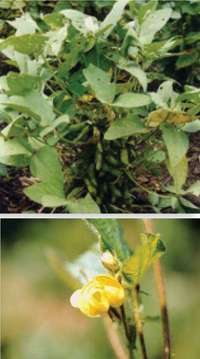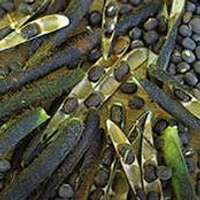
Figure 17. Immature black gram plant (top) and flower (bottom). Source: ECHO Staff
Black gram (Vigna mungo) is native to the Indian Subcontinent (Royal Botanic Gardens, Kew, 2025), from the seasonally dry (Ustic soils) areas. Black gram is an erect, bushy, hairy, herbaceous legume reaching 30 to 100 cm in height with trifoliate leaves (Figure 17). It has small yellow flowers (Figure 17) and short flat pods reaching 4 to 6 cm (FAO, 2022) with 4 to 10 black or mottled colored seeds (Figure 18).

Figure 18. Black gram seeds. Source: ECHO Staff
Once established, it is drought resistant because of its taproot that explores deeper soil for water and allows it to survive on residual soil moisture after the rainy season. Black gram is used as a pulse, cover crop/green manure, and fodder in many cropping systems.
Cultivation
A wide temperature range of 8 to 40°C reflects its elevation range of up to 2000 m (FAO, 2022). Black gram thrives in heavier to moderately textured pH-neutral soils that are at least 50 cm deep and well-drained.
Working with multiple varieties, Veeramani (2019) found that a 20 x 10 cm spacing resulted in higher yields than a recommended spacing of 30 x 10 cm. To reduce disease incidence, farmers space plants further apart in the wetter season (for increased air circulation under humid conditions), and closer when it is drier.
Sow seeds 5 to 6 cm deep and ensure enough water for germination, flowering, and pod development (Nargund et al., 2024). Vermicompost-treated soil has been shown to facilitate good germination and early growth parameters of seedlings (Bhattacharya et al., 2019).
Common rotations with black gram include maize (Zea mays), potato (Solanum tuberosum), rice (Oryza sativa), wheat (Triticum aestivum), mustard (Brassica juncea), toria (Brassica rapa), and include intercropping with pigeon pea (Cajanus cajan), sugarcane (Saccharum officinarum), sunflower (Helianthus annuus), groundnut (Arachis hypogaea), sorghum (Sorghum bicolor), and pearl millet (Pennisetum thypoides) (DPD, 2016; Soundararajan and Chitra, 2012). Farmers also plant black gram as a catch crop9 (Nargund et al., 2024).
Control weeds early to avoid competition for space and nutrients. Choudhary et al. (2012), found two weeding events, one at 15 and another at 25 to 30 days after seeding, controlled weeds sufficiently.
Harvest green pods in 60 to 80 days, and mature beans in 75 to 130 days (FAO, 2022). Harvest grain when 70 to 80% of the pods turn black and are mature to avoid pod shattering in the field (Nargund et al., 2024). Dry the pods for a few days before threshing. Dry the seeds in the sun for 3 to 4 days, reducing seed moisture content to 8 to 10% before storage.
Pests and diseases
Fungal diseases that commonly affect black gram include powdery mildew (fungal order Erysiphales), leaf blight (Cercospora canescens), and anthracnose (Colletotrichum spp.). Wider spacing helps reduce fungal disease severity. To reduce transmission, remove and destroy affected plant residues or rogue (remove) affected plants. To control, apply sulfur or Bordeaux mixtures (CuSO4) according to local recommendations. Some botanicals have also shown promise for controlling certain diseases. Leaf extract of neem (Azadirachta indica) at 100% concentration retarded germination of pathogen (leaf blight) spores; and soil disinfestation with crucifer (Brassicaceae) residue and solarization helped release substances which inhibited Fusaruim oxysporum, an indicator of soil-borne pathogen control (Iqbal et al., 2019; Uddin et al., 2013).
Yellow mosaic virus also affects black gram. Control its insect vector, whitefly (Bemisia spp.), and rogue infected plants to help control the spread of the virus.
Table 2 summarizes a review by Nargund et al., 2024 of major insect pests and proposed IPM practices.
| Pest | IPM practice |
|---|---|
| Aphids (Aphis craccivora) | Spray with 5% crude neem extract or 2% neem oil at 3000 ppm |
| Spotted Pod Borer (Maruca vitrata) | Shake infested plants over containers of oil, water, or greasy substances will help to reduce the population. Apply Bacillus thuringiensis (Bt) and/or spinosads, two natural control options. |
| Pod Bug (Clavigralla gibbosa) | Apply commercialy available neem preparations, during flowering and pod formation (this proved effective for pigeon pea [Cajanus cajan; Chethan et al.,2024]) |
| Tobacco Caterpillar (Spodoptera liturga) | Collect and destroy egg masses and newly hatched larvae along with affected leaves to reduce infestation. Try clean cultivation to expose pupae to natural enemies. Plant trap crops such as sunflower to attract S. litura. Apply Bacillus thuringiensis (Bt) (EPPO, 2023). |
Stored Grain
Pulse beetle (Callosobruchus chinensis) is a pest of stored grain. Black pepper (Piper nigrum), neem oil, and mustard oil effectively protected harvested black gram for 5 months (Thakur and Pathania, 2013). Farmers can use these products for safe seed storage as they are available in the local markets and non-toxic.
References
Bhattacharya, S., S. Debnath, S. Debnath, and, A.K. Saha. 2019. Effects of vermicompost and urea on the seed germination and growth parameters of Vigna mungo L. and Vigna radiata L. Wilzek. Journal of Applied and Natural Science,11(2): 321- 326. https:// doi.org/10.31018/ jans.v11i2.2052
Chethan B.R., V. Rachappa, S.G. Hanchinal, N.R. Harischandra, and S.R. Doddagoudar. 2024. Efficacy of biopesticides against pod bug, Clavigralla gibbosa Spinola (Heteroptera; Coreidae) in pigeonpea. Legume Research. 47(2): 323-327. doi: 10.18805/LR-4661.
Choudhary, V.K., P.S. Kumar, and R. Bhagawati. 2012. Integrated weed management in blackgram (Vigna mungo) under mid hills of Arunachal Pradesh. Indian Journal of Agronomy 57 (4): 382-385. https://pub.isa-india.in/index.php/ija/article/view/4651/4326
Directorate of Pulse Development (DPD). 2016. Department of Agriculture and Farmers Welfare, Government of India. Urdbean. Accessed August 22, 2025. https://dpd.gov.in/Urdbean.PDF.
EPPO. 2023. European and Mediterranean Plant Protection Organization (EPPO).EPPO Global Database. Search term “Spodoptera litura”. https://gd.eppo.int/taxon/PRODLI/download/datasheet_pdf
Food and Agriculture Organization of the United Nations. 2022. ECOCROP – Find Plant. GAEZ v4 Data Portal. https://gaez.fao.org/pages/ecocrop-find-plant.
Iqbal, J., U. Yousaf, S. Zia, A. Asgher, R. Afzal, M. Ali, A.U.R. Sheikh, and A. Sher. 2019. Pulses Diseases “Important Limiting Factor in Yield” and Their Managements. Asian Journal of Research in Crop Science 3(2): 1-21.
Nargund, M.I., R. Singh, A. Singh, S. Pazhanisamy, and S. Sarkar. 2024. How to cultivate productive and profitable Urd bean (Black gram) in Summer Season. Indian Farmer. Vol. 11 (10): 442-448. https://indianfarmer.net/uploads/cultivation%20of%20black%20gram%20in%20summer%20season.pdf
Royal Botanic Gardens, Kew. 2025. Plants of the World Online. Accessed August 25, 2025. https://powo.science.kew.org/taxon/urn:lsid:ipni.org:names:525443-1
Soundararajan, R.P. and N. Chitra. 2012. Impact of intercrops on insect pests of Blackgram, Vigna mungo L. Journal of Entomology 9(4):208-219. DOI:10.3923/je.2012.208.219
Uddin, M.N., M.A. Bakr, M.R. Islam, M.I. Hossain, and A. Hossain. 2013. Bioefficacy of plant extracts to control cercospora leaf spot of mungbean (Vigna radiata). International Journal of Agricultural Research, Innovation and Technology 3(1):60-65. http://www.ijarit.webs.com
Thakur, A.K. and M. Pathania. 2013. Biology of Pulse Beetle (Callosobruchus chinensis) and Its Management through Plant Products on Black Gram (Vigna mungo). Science, Technology and Arts Research Journal. Vol. 2(1). DOI:10.4314/star.v2i1.98838
Veeramani, P. 2019. Effect of plant spacing on the growth and yield of blackgram (Vigna mungo). Journal of Krishi Vigyan. 8(1): 101-104 DOI : 10.5958/2349-4433.2019.00073.4